We all know caffeine can give us the energy boost we need to power through our day, but could it also influence our hormones unexpectedly? Specifically, does caffeine impact testosterone levels, the hormone essential for muscle development, energy, and sexual well-being? The truth is that the relationship between caffeine and testosterone is more complex than you might think. While some studies suggest it could provide a slight boost, others indicate it might lower testosterone levels. This evidence-based review analyzes how caffeine affects testosterone, fertility, and erectile function, offering expert insights into its health and performance outcomes.
Caffeine has been studied for its impact on fertility, with mixed results across both male and female fertility studies.
In males, studies have shown that caffeine from coffee, tea, or cocoa drinks does not significantly affect semen quality, including sperm count or concentration.
Meanwhile, caffeine from cola and soft drinks has been linked to lower semen volume and concentration.
Caffeine consumption was also associated with sperm DNA damage, including aneuploidy and DNA breaks, which may negatively impact male fertility.
Additionally, male coffee intake was associated with extended time to conception for couples.
For females, higher caffeine intake, particularly between 300 mg and 600 mg daily, has been associated with an increased risk of miscarriage.
The risk rises by 37% at 300 mg and 132% at 600 mg daily.
However, no clear association was found between caffeine consumption and natural fertility or fertility treatment outcomes, such as clinical pregnancy or live birth rates.
The effect of caffeine on testosterone levels is complex and influenced by factors like dosage, duration of consumption, and individual differences.
Using data from 372 adult males in the 2013–2014 NHANES survey, the study investigated how caffeine affects testosterone levels in males.
It found that higher caffeine intake was linked to lower testosterone levels.
Some caffeine byproducts, such as 5-methyluric acid, were particularly associated with lower testosterone.
On the other hand, 7-methylxanthine seemed to raise testosterone levels.
These results indicate that caffeine could lower testosterone, but more research is needed to clarify the mechanisms behind this effect.
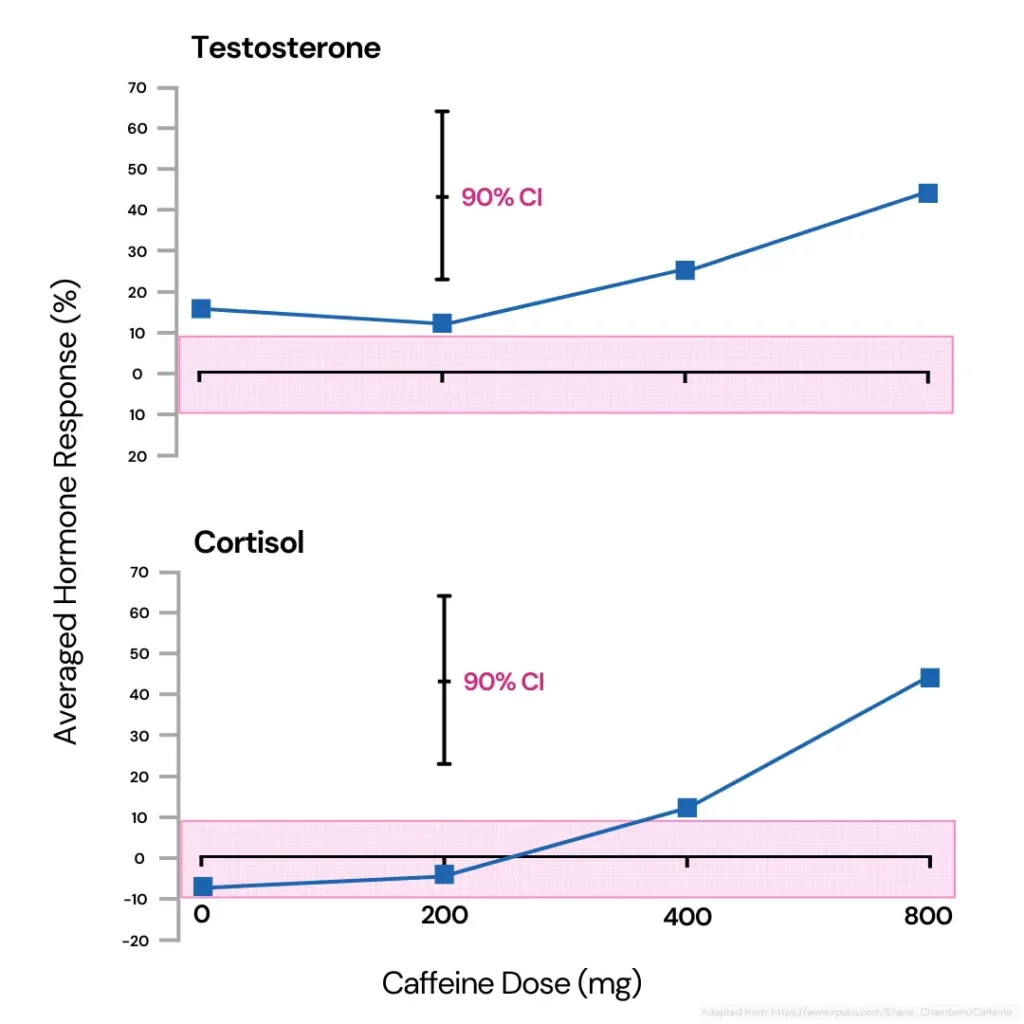
This study examined how caffeine affects testosterone and cortisol levels in professional athletes during exercise.
Rugby players took different amounts of caffeine (from 0 to 800 mg) before working out.
The results showed that caffeine caused a small increase in testosterone during exercise. At the highest dose (800 mg), testosterone went up by 21%.
However, this was also linked to a significant rise in cortisol, a stress hormone, which can work against the benefits of increased testosterone.
Higher cortisol levels lead to a reduced testosterone-to-cortisol ratio, which may limit the effectiveness of caffeine in boosting testosterone.
While caffeine can help with performance, the cortisol spike might limit these benefits.
This 8-week randomized controlled trial examined how caffeinated and decaffeinated coffee affects hormones in healthy adults.
After the 8 weeks, no significant changes were found in any of the results, including testosterone levels, from coffee consumption. However, at the 4-week mark, there were some notable differences:
Thus, further research is needed to clarify these associations and understand the underlying biological mechanisms.
Caffeine withdrawal's impact on testosterone levels is generally minimal and indirect.
Although some studies indicate that caffeine may temporarily boost testosterone, quitting coffee is unlikely to cause a significant decrease in levels.
The primary way withdrawal could affect testosterone is through increased stress, as the symptoms can raise cortisol levels.
Prolonged high cortisol can interfere with testosterone production, but this effect is usually temporary and fades as the body adapts to being caffeine-free.
Insights from healthcare professionals reveal how caffeine impacts testosterone levels.
| Andrew Huberman, Ph.D. (neuroscientist and podcaster at Stanford) |
| "Caffeine can slightly raise SHBG, which may reduce free testosterone levels. However, the impact is minor and doesn't exceed the benefits of proper caffeine consumption, enhancing mental and physical performance." |
| Dr. Jolene Brighten, NMD (naturopath and women's hormone expert) |
| "While studies on men suggest caffeine may lower testosterone levels, the impact on women is less clear. Some studies show caffeine could reduce testosterone in women but increase it in men. Overall, the results are mixed, and whether caffeine lowers testosterone likely depends on the individual." |
| Dr. Sam Robbins (anti-aging and hormone specialist) |
| "Caffeine can trigger a rise in stress hormones like cortisol and adrenaline, which decreases testosterone and can result in a decrease in erections." |
Caffeine's influence extends to several other hormones, including:
Enjoying coffee doesn't have to come at the cost of your health—simple strategies can help you optimize its intake:
Note: These are general tips, and caffeine’s effects may vary from person to person. For any concerns, it’s advisable to consult a healthcare provider.
Caffeine may have a minimal effect on testosterone levels. Some evidence suggests a slight increase during exercise, with a 21% rise at high doses.
However, other findings indicate that caffeine's byproducts could decrease testosterone.
The overall effect varies between individuals, and more research is needed to understand its precise influence on testosterone.
Quitting coffee is not likely to cause a significant decrease in testosterone levels.
The connection between caffeine and testosterone is complex, with studies like the NHANES study by Lopez et al. showing non-linear associations.
This means the effect of caffeine on testosterone can vary depending on factors like consumption levels and individual variations.
Caffeine may enhance erectile function by improving blood flow to the penis.
Studies suggest that moderate coffee consumption—about 2 to 3 cups a day—can help males get and sustain an erection.
Drinking 85-170 milligrams of caffeine each day is linked to a 42% lower risk of erectile dysfunction (ED).
Males who consume 171-303 milligrams daily have a 39% lower chance of ED compared to those who don’t drink caffeine.
This positive effect could be due to caffeine’s ability to relax the arteries and smooth muscles in the penis, which boosts circulation.
Additionally, caffeine may increase testosterone levels, an essential factor since low testosterone is often linked to ED.
However, some recent studies have found no clear connection between caffeine and ED, indicating that the effects may vary from person to person.
Caffeine doesn't directly block hormones in the way a medication might. Instead, it interacts with your body in ways that can influence hormone levels.
Some hormones that caffeine can affect include:
Several factors can significantly lower testosterone, including:
Caffeine’s impact on testosterone is complex, with studies showing mixed results.
Some evidence suggests it can temporarily boost testosterone during exercise, while other findings indicate caffeine’s byproducts may lower testosterone in males.
Caffeine can negatively affect male fertility by reducing sperm quality and DNA health. In females, high caffeine intake elevates the risk of miscarriage.
Moderate caffeine consumption may improve erectile function and lower the risk of ED.
Caffeine withdrawal can cause temporary stress and elevated cortisol but doesn’t significantly lower testosterone.
The overall effects of caffeine on hormones vary based on individual factors, dosage, and lifestyle.
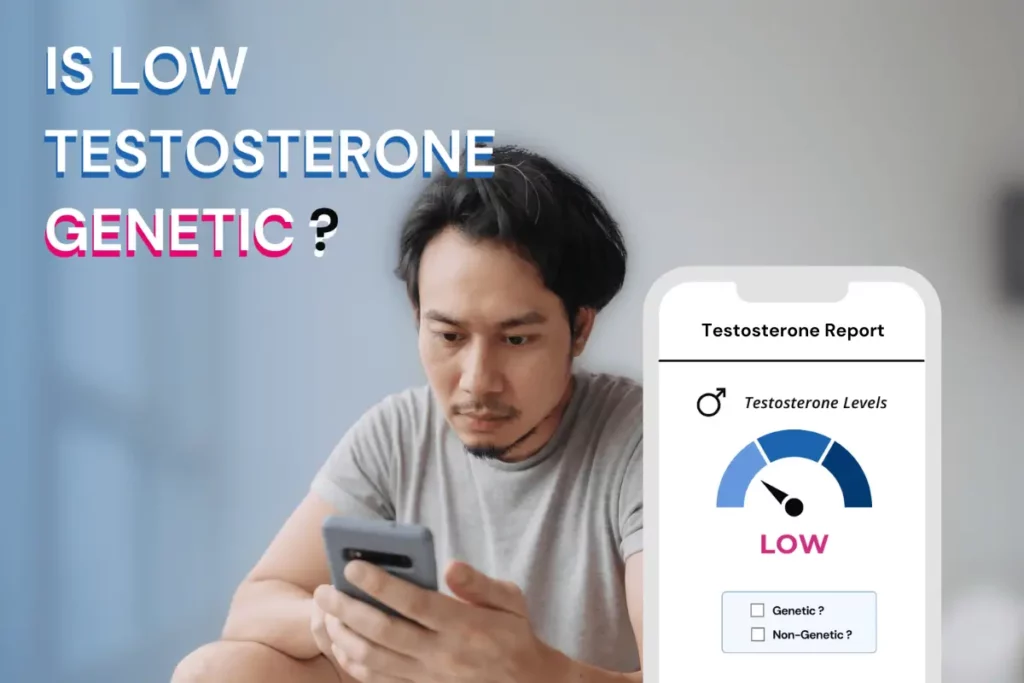
Is Low Testosterone Genetic?

Can Caffeine Cause Dizziness? Tips To Avoid Side Effects

How Much Caffeine Is Safe During Pregnancy?
https://pmc.ncbi.nlm.nih.gov/articles/PMC5482951
https://pmc.ncbi.nlm.nih.gov/articles/PMC5733907
https://pmc.ncbi.nlm.nih.gov/articles/PMC9112543
https://pubmed.ncbi.nlm.nih.gov/18458357
https://pmc.ncbi.nlm.nih.gov/articles/PMC3502342
https://pmc.ncbi.nlm.nih.gov/articles/PMC2257922
https://ai.hubermanlab.com/s/848d01de-6c88-11ef-a5a9-2b312bd75228
https://drbrighten.com/how-coffee-affects-your-health-and-hormones
https://www.betterhealth.vic.gov.au/health/healthyliving/caffeine
https://pmc.ncbi.nlm.nih.gov/articles/PMC6758129
https://pmc.ncbi.nlm.nih.gov/articles/PMC6298130
https://journals.plos.org/plosone/article?id=10.1371/journal.pone.0123547
https://jhpn.biomedcentral.com/articles/10.1186/s41043-024-00645-w
https://www.acs.org/education/chemmatters/past-issues/archive-2013-2014/caffeine.html
https://www.webmd.com/diabetes/diabetes-and-caffeine
https://pubmed.ncbi.nlm.nih.gov/14592218
https://www.healthline.com/health/testosterone-killing-foods
The study of genetics and epigenetics helps us understand the complex factors influencing an organism’s health and development. Genetic studies focus on inherited traits, while epigenetics looks at how lifestyle, diet, and stress affect gene expression without altering the DNA sequence. This distinction highlights the dynamic relationship between nature (genetics) and nurture (environment), emphasizing that both play crucial roles in shaping health outcomes. One gene of interest in this context is MTHFR (methylenetetrahydrofolate reductase). It’s a gene involved in the methylation process, a key aspect of epigenetics. Keep reading to explore how environmental and lifestyle factors affect gene function and contribute to changes in methylation.
Genetics refers to the study of genes and how they influence the traits and characteristics of an organism.
Genes are inherited from parents and provide the blueprint for various biological functions.
Unlike genetics, epigenetics focuses on gene activity changes without altering the DNA sequence.
Epigenetics shows that an organism's environment can influence gene expression, sometimes overriding genetic predispositions.
For example, studies have shown that even mice with genetic predispositions to certain diseases can have healthy offspring if raised in a good environment.
MTHFR, or methylenetetrahydrofolate reductase, is a gene that plays a crucial role in processing folate (vitamin B9) and regulating homocysteine levels in the body.
This gene can be influenced by epigenetic factors, which are changes that affect gene activity without altering the DNA sequence itself.
Methylation is a common epigenetic change that acts like a switch.
It turns a gene 'off' when its functioning is not required.
MTHFR is a vital enzyme in the methylation cycle. It is responsible for converting folate into its active form, 5-MTHF.
This active folate helps convert homocysteine into methionine, a protein-building block.
In some cases, the MTHFR gene can become over-methylated due to mutations, reducing its expression and lowering enzyme activity.
MTHFR hypermethylation occurs when excess methyl groups attach to the MTHFR gene's promoter region, reducing its activity and the production of the MTHFR enzyme.
This reduction can disrupt essential processes and lead to several health issues, including:
The Xcode Life Methylation Genetic Test utilizes raw data obtained from popular ancestry genetic testing service providers like 23andMe, Ancestry DNA, Family Tree DNA (FTDNA), Living DNA, and My Heritage to provide the MTHFR and Methylation report.
The test analyzes more than 15 genes associated with the methylation pathway, including MTHFR, MTRR, MTR, COMT, and AHCY.
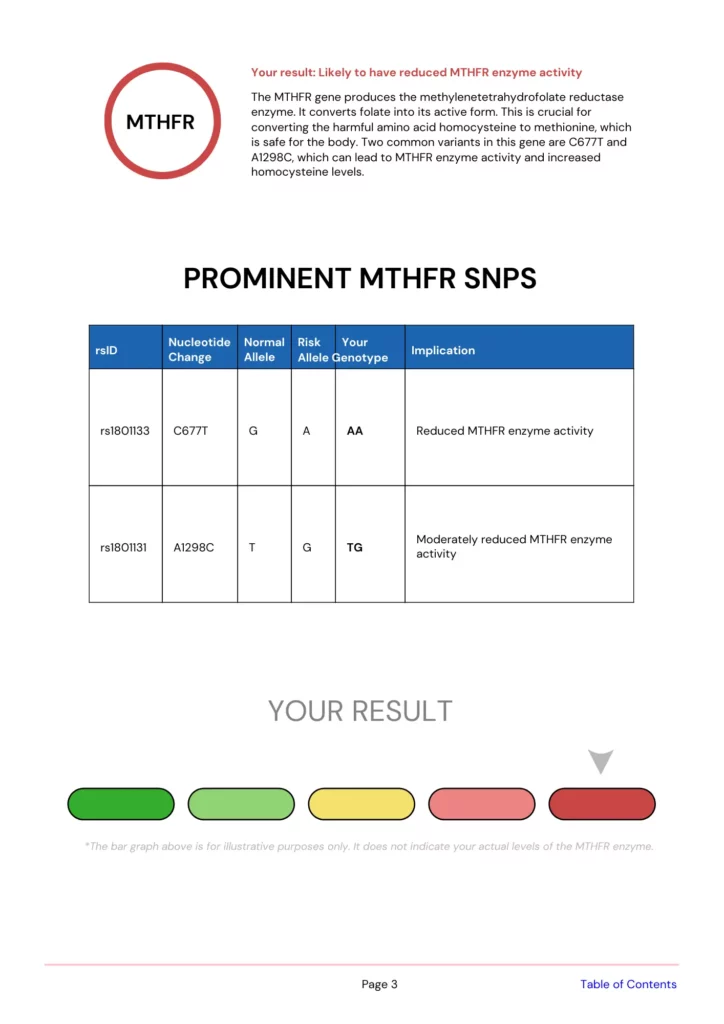


For a sample MTHFR report/ preview of the report, click here.
Maintaining proper MTHFR methylation and epigenetic balance starts with smart dietary and supplement decisions.
Explore the foods and supplements highlighted below to support these goals.
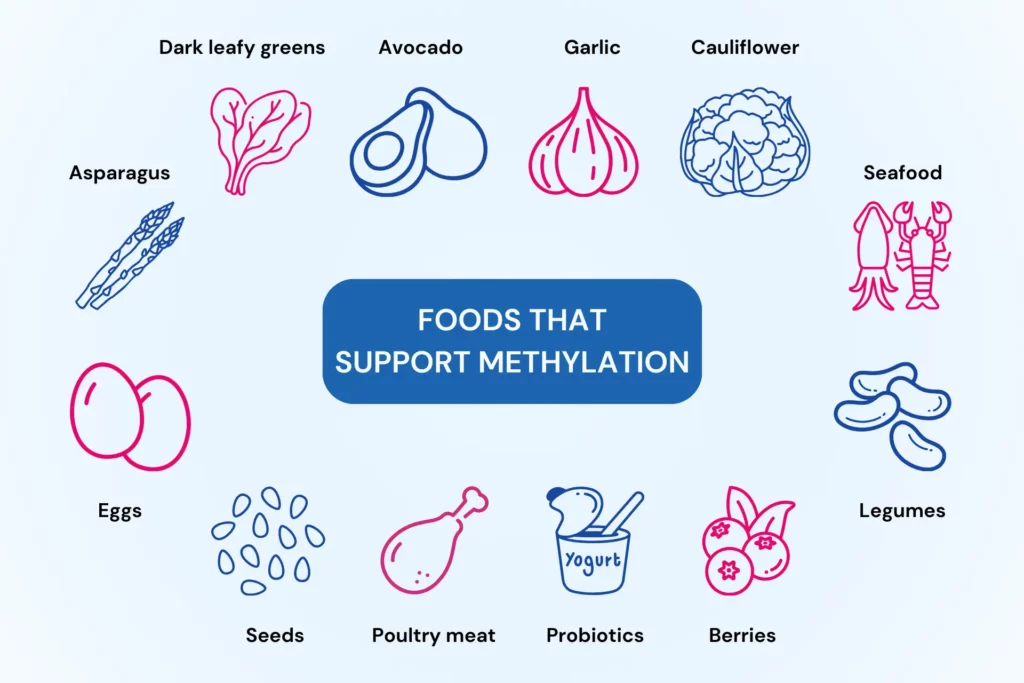
Dr. Josh Axe, a chiropractor and clinical nutritionist, states that certain lifestyle habits can help support normal MTHFR methylation, regardless of individual genetic factors.
These habits include consuming nutrient-rich foods such as folate, B vitamins, magnesium, and zinc.
Some of the best foods to support methylation include:
Specific supplements may help facilitate healthy epigenetic modifications like methylation. These supplements often contain:
Other compounds, such as curcumin (from turmeric), green tea extract, sulforaphane, and resveratrol, are also studied for their potential epigenetic effects.
Note: Always consult a healthcare provider first to ensure the chosen supplements are appropriate for your health.
Yes, methylation is a form of epigenetics. It acts as a molecular switch, attaching a methyl group to DNA and thus regulating gene activity by turning genes on or off without changing the DNA sequence.
This control is essential to numerous biological functions, including disease development.
Epigenetic changes can alter gene expression and contribute to the development of various diseases.
Some of the diseases influenced by epigenetic factors include:
As demonstrated in a recent clinical trial, epigenetic changes are reversible.
The study involved 43 healthy adult males aged 50-72 participating in an 8-week treatment program.
This program included guidance on diet, sleep, exercise, relaxation, and the use of supplemental probiotics and phytonutrients. The control group did not receive any intervention.
The researchers measured epigenetic aging using a method called the Horvath DNAmAge clock.
The results showed that the treatment group had a 3.23-year decrease in epigenetic age compared to the control group.
Within the treatment group, their epigenetic age decreased by 1.96 years on average during the program.
Additionally, there were improvements in blood markers, such as a 15% increase in a nutrient called 5-methyltetrahydrofolate and a 25% decrease in triglycerides.
While this study suggests lifestyle changes may reverse epigenetic alterations, further research can confirm its claim.
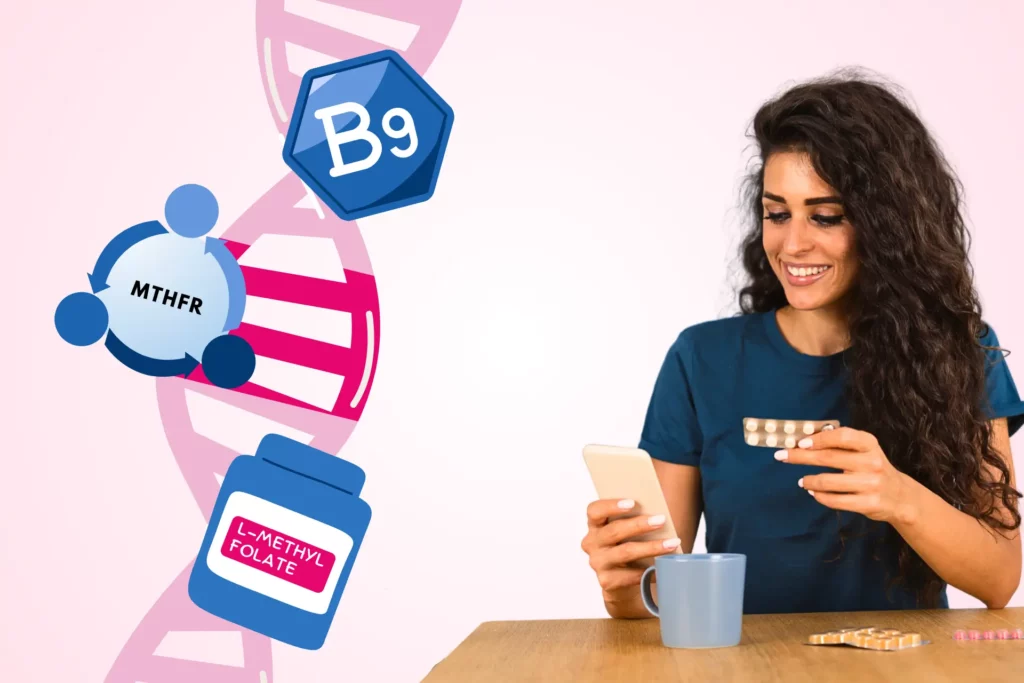
What Is The Best Multivitamin For MTHFR Mutation?
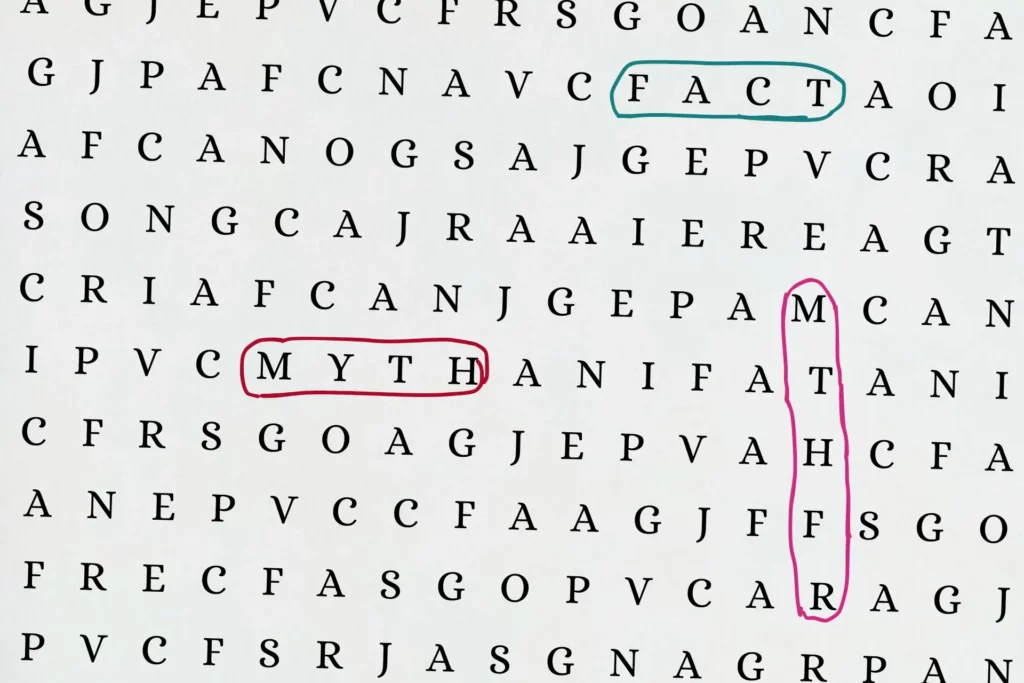
MTHFR Mutations: Myths vs. Facts
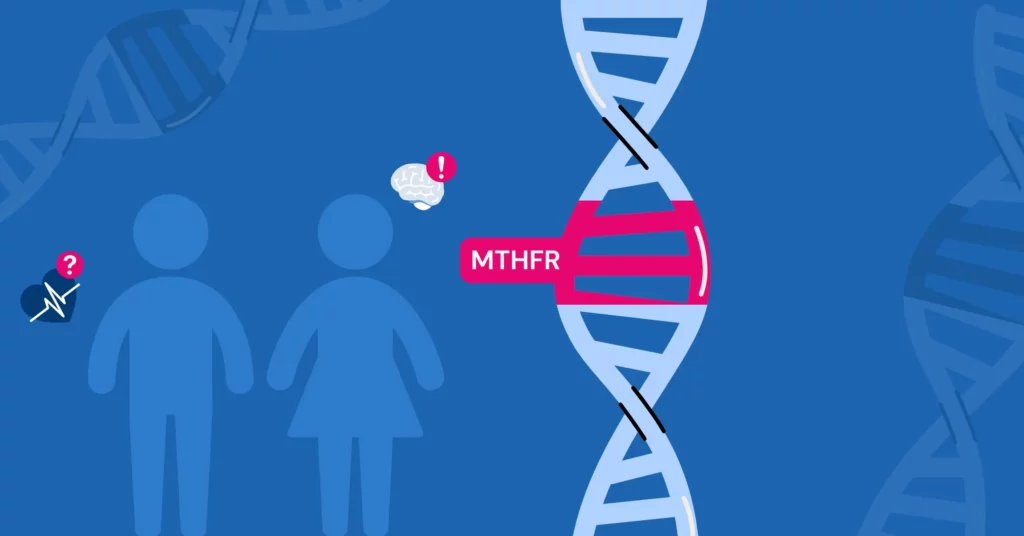
MTHFR Symptoms in Children: Genetic Mutations and Health Impacts
https://pmc.ncbi.nlm.nih.gov/articles/PMC3193653
https://dmsjournal.biomedcentral.com/articles/10.1186/s13098-017-0284-3
https://pmc.ncbi.nlm.nih.gov/articles/PMC6359124
https://pmc.ncbi.nlm.nih.gov/articles/PMC5735284
https://pmc.ncbi.nlm.nih.gov/articles/PMC8339558
https://www.sciencedirect.com/science/article/abs/pii/S1751499110000417
https://www.mdpi.com/2072-6643/16/5/678
https://pmc.ncbi.nlm.nih.gov/articles/PMC7750768
https://pmc.ncbi.nlm.nih.gov/articles/PMC8327151
https://www.sciencedirect.com/science/article/pii/S0925443916303246
https://pmc.ncbi.nlm.nih.gov/articles/PMC8064200
We often hear stories about people who eat specific foods like nuts, seafood, etc., and develop a rash on their bodies or breathing difficulties. These instances occur because an individual eats a food they are allergic to. If there was a way to determine what foods you are allergic to, most people could avoid the foods that cause them allergies. The good news, however, is that there are tests that help identify foods that may trigger an allergic reaction. In this artilce, we will learn more about food sensitivity tests—their types, uses, and more.
Before understanding more about food sensitivity tests, let’s get our terminologies right!
Food sensitivity, intolerance, and allergy are often used interchangeably.
However, these are not the same.
With food intolerances, the body lacks certain enzymes necessary to break down a particular food item.
Food intolerance may cause stomach upset or other digestive problems.
They are not related to the immune system, nor are they typically life-threatening.
This stems from an immune reaction and is driven by antibodies like immunoglobulin G (IgG), immunoglobulin M (IgM), and immunoglobulin A (IgA).
Symptoms of food sensitivity include digestive issues like gas, diarrhea, abdominal pain, joint pain, brain fog, and migraine.
These food sensitivity symptoms are subtle and usually do not occur immediately.
Food sensitivities are mostly not life-threatening.
These are severe immune reactions to certain foods due to increased immunoglobulin E (IgE) production.
The symptoms of food allergy usually occur within 2 hours of eating the food and may include:
Food allergies can result in anaphylactic reaction, which is a life-threatening complication.
| Feature | Food Allergy | Food Intolerance | Food Sensitivity |
| Involvement | Immune system (IgE response) | Digestive system | Immune response (non-IgE) |
| Symptoms Onset | Rapid (minutes to hours) | Delayed (hours to days) | Delayed |
| Severity | Potentially life-threatening | Generally less severe | Varies |
| Common Examples | Peanuts, shellfish | Lactose intolerance | Gluten sensitivity |
Food sensitivity occurs when the body launches an immune reaction against a food that has been ingested.
It does so by producing antibodies.
Food sensitivities typically result from a combination of digestive issues, gut health, and environmental factors.
Here are some key causes:
Research suggests that gut microbiome imbalances can influence immune function and may contribute to adverse food reactions.
For example, conditions such as leaky gut syndrome, where the intestinal barrier becomes permeable, may allow undigested food particles to enter the bloodstream, triggering immune responses and sensitivities.
Stress, medications (like antibiotics), and poor dietary habits can contribute to or exacerbate food sensitivities.
Diets high in processed foods and low in fiber can reduce microbiome diversity and impair immune function.
Over time, this may predispose individuals to various intolerances or sensitivities.
There is a genetic component to food sensitivities.
Individuals with a family history of allergies or intolerances may be more prone to developing similar issues themselves.
The best way to deal with food sensitivity is to avoid the food causing the symptoms.
In some cases, the food sensitivity may go away with time.
But do all food sensitivities go away? Well, there is no definitive answer to that!
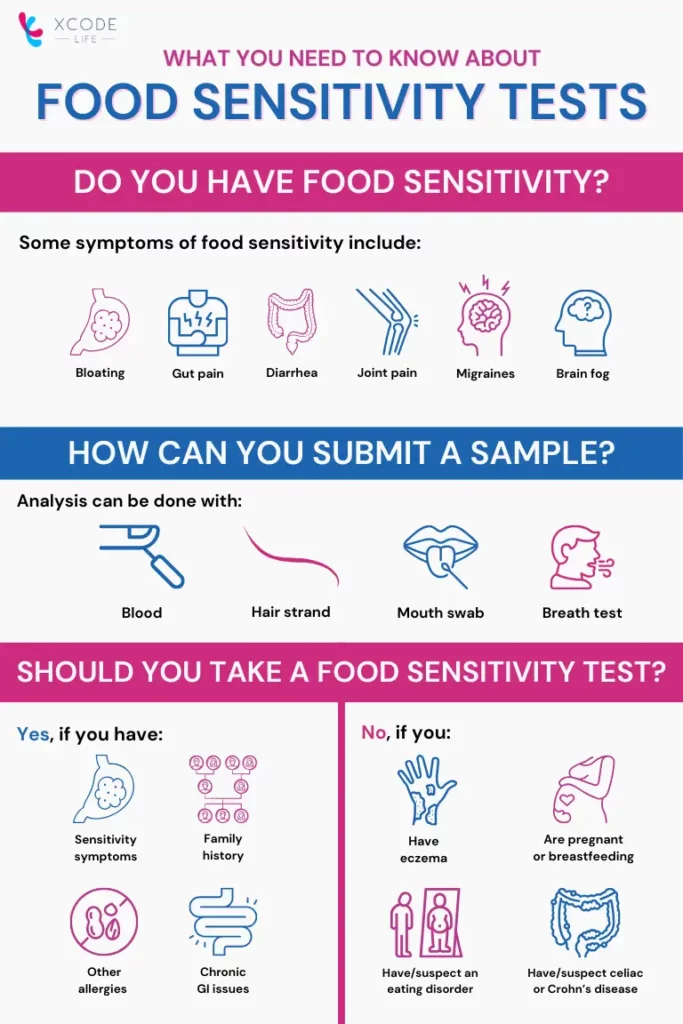
Food sensitivity tests measure the body’s immune response to certain foods.
During food sensitivity, the body produces IgG, IgM, and IgA, as well as white blood cells and other immune system molecules to interact with and react to the consumed foods.
These can be measured to confirm sensitivities to food items.
Besides lab tests, several companies today offer at-home food sensitivity testing that claims to help an individual gain better insight into the foods that may be causing uncomfortable digestive symptoms.
You will require a testing kit to test for food sensitivities at home.
Depending upon the test kit, you will need to submit a sample of one of the following:
Different at-home testing kits provide specific instructions on how to perform the test.
You must collect the sample after you have been exposed to food allergens.
Most companies provide their results within a few days to weeks.
Food sensitivity tests are recommended for people with:
One must always get a food sensitivity test after eating the food they suspect they are sensitive to.
So, people with eczema or severe food sensitivity must avoid this test.
There are several at-home food sensitivity tests that you can try. Here’s a quick comparison of the most popular ones.
| EverlyWell Food Allergy Test | Labcorp Food Allergy Test | Quest Food Allergy Test Panel | |
| Pricing | $149 | $199 | $179 |
| Global availability | Available in the USA and some online retailers | Available in the USA and some online retailers | Available in the USA and some online retailers |
| Reviews | Positive: The company has received positive reviews from consumers who report that their home-testing experience is easy and that they received the results quickly. Negative: A few negative feedbacks include: difficulty in collecting enough blood, delayed processing of reports, loss of reports, difficulty in reaching customer care, concerns about test accuracy | This is one of the few tests that are CLIA-approved and allow for mailing the samples. The results are available digitally but take longer than those of the competitors. | There are limited reviews about Quest Diagnostics’ food allergy test The company is still |
| Opinion | This is one of the few tests that are CLIA-approved and allow for mailing the samples. The results are available digitally but take longer than those of the competitors. | Though it is the most expensive home food sensitivity test, it detects about 12 foods that can trigger an allergic reaction. | While this test measures around 15 foods, the doctor must pay an additional fee to review the results. Patients are also supposed to go to give their blood samples, which makes it tedious compared to other home test kits. |
The American Academy of Allergy, Asthma & Immunology (AAAAI) states that the presence of IgG in blood samples tested by home kits is not a reliable identifier for food allergens.
Increased IgG levels may also result from a normal body response to food exposure.
Some research states that food sensitivity tests that rely on genetic testing are not accurate enough for diagnostic use.
Here's why:
While traditional food sensitivity tests have their limitations, exploring your genetic predispositions can offer valuable insights into how your body might react to certain foods or drugs.
At Xcode Life, our Allergy and Drug Sensitivities Report uses your existing ancestry test raw DNA file to provide an added layer of information about your potential sensitivities.
Rated 4.7/5 By Users Like You
This report is not a diagnostic tool but a resource to help you better understand your genetic tendencies. Combined with advice from a healthcare professional and other diagnostic methods, it can guide more informed lifestyle and dietary choices.
Since food sensitivity tests are not reliable to determine if you are allergic to specific foods, your doctor will perform a comprehensive evaluation, which may include:
While some tests, like IgG antibody testing, claim to identify food sensitivities, they are not always scientifically validated.
Many practitioners prefer an elimination diet under their supervision as a more reliable method to identify sensitivities.
The value of a food sensitivity test depends on your symptoms and goals.
These tests might provide a starting point if you're experiencing unexplained digestive issues, migraines, or fatigue.’
While these tests provide a starting point for unexplained digestive issues, fatigue, or migraines, their results may be inconclusive or lead to unnecessary dietary restrictions.
The cost varies widely depending on the type of test and provider/company.
Food sensitivity tests start at $100 and can reach around $300.
Some comprehensive and advanced lab tests, like Zoomer panels, may cost $400 to $600.
Check with your provider to see if the test is covered by insurance.
A Zoomer test is an advanced diagnostic tool for detecting food sensitivities, intolerances, and cross-reactivity at a detailed level.
These tests analyze peptides (small protein fragments) rather than whole proteins, giving you more precise results.

Check Your Gene Variants For Lactose Intolerance
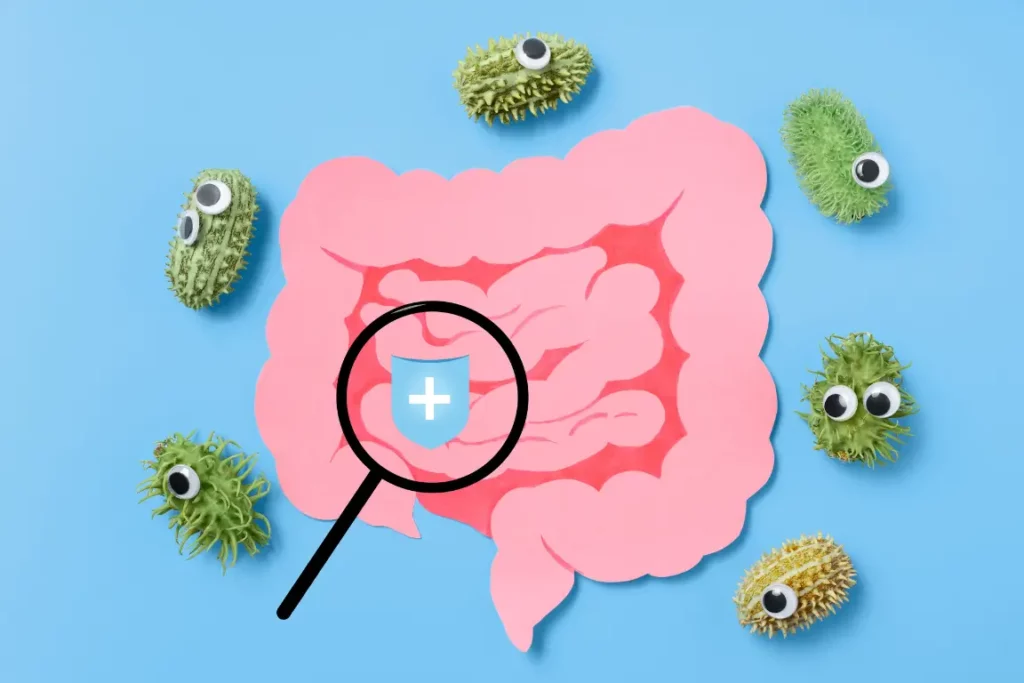
Are Postbiotics Better Than Probiotics For Gut Health?
The MTHFR gene is key to a process called methylation, which pretty much runs the entire show in our human body, regulating innumerable critical functions. The importance of a well-functioning methylation cycle, thus, cannot be overstated. But when there are unfavorable changes in the MTHFR gene, methylation could be affected, increasing your risk for numerous health conditions. A genetic methylation test is a simple way to identify whether or not you carry the MTHFR gene changes. Well, what if you do? The fix is as simple as it gets. Read on to learn more about MTHFR and methylation, how to get a genetic methylation test, and ways to combat MTHFR mutations.
Methylation is a critical biochemical process within the human body, governing myriad functions from DNA production to brain chemical synthesis.
This intricate process is vital in regulating key bodily systems, including cardiovascular, neurological, reproductive, and detoxification pathways.
At its core, methylation is about turning biological gears and switches on and off, enabling the body to function optimally.
Central to this process is the MTHFR gene, which encodes for the enzyme methylenetetrahydrofolate reductase.
This enzyme is instrumental in processing amino acids, the fundamental building blocks of proteins. MTHFR's significance is particularly pronounced in a chemical reaction involving different forms of vitamin B9 (folate).
This reaction is a crucial step in the methylation process.
The MTHFR enzyme also aids in converting homocysteine into methionine, an essential compound needed by the body for protein synthesis and the formation of other critical substances.
In the study of genetics, a variant refers to any deviation in the DNA sequence from what is typically expected.
Focusing on the MTHFR gene, each individual carries two copies of this gene, inheriting one from each parent.
Approximately 40% of the adults carry at least one mutation or variant in the MTHFR gene, which leads to less than optimal enzyme activity.
The two common variants in the MTHFR gene are:
The presence of these variants can lead to elevated levels of homocysteine in the blood.
Homocysteine is an amino acid that, at high levels, may be associated with a range of health issues, including:
Understanding the possible genotypes for these MTHFR variants is crucial in determining an individual’s genetic predisposition to these health issues.
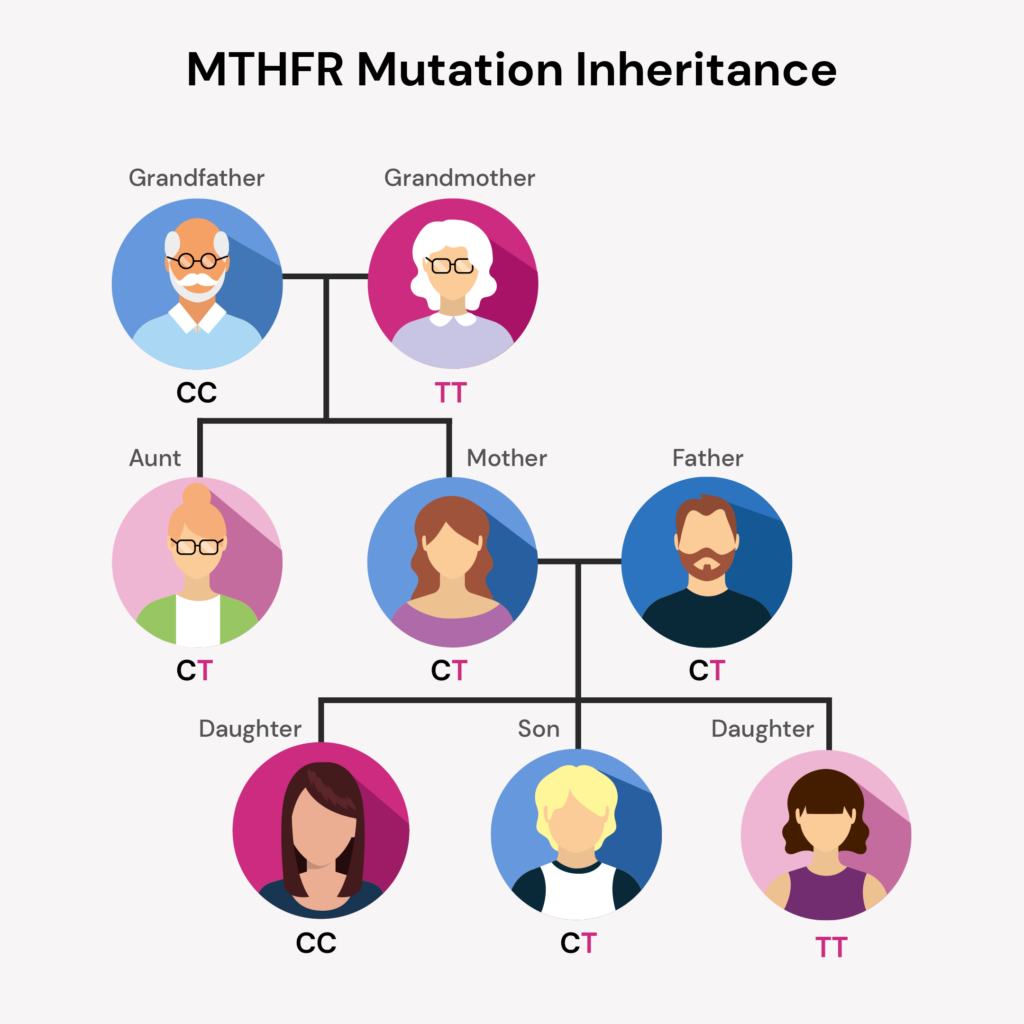
The methylation pathway in our bodies is influenced by many genes. The most important one is the MTHFR gene. Others include:
A methylation genetic test analyzes these genes associated with the methylation pathway to look for any changes or variants that may result in less-than-optimal functioning.
The results can help you understand your methylation status and underline nutritional needs to support your methylation.
A genetic methylation test typically costs between $200 and $500, depending on the specific panel and lab used.
However, some DNA analysis companies let users upload their existing raw DNA files to avail the methylation report for a lower cost.
More comprehensive tests that include blood biomarkers, etc, can cost up to $1,000.
The following are some popular choices for a genetic methylation test.
| Company | Test | Price |
| Xcode Life | 15 gene panel, 60 variant methylation report | |
| StrideDNA | 19 gene panel | |
| LifeDNA | 12 gene panel | $249 |
| 10X Health System Gary Brecka | ~5 methylation genes | $599 |
Clinical methylation tests will mostly require a visit to the lab, where a clinician will provide guidance.
You can find your nearest lab here.
Many direct-to-consumer genetic testing companies also offer genetic methylation tests.
Some ship out DNA kits, which you can collect your sample and ship back. Some areas may be unserviceable.
Services like Xcode Life allow you to upload your existing ancestry test raw DNA file to provide a comprehensive methylation report.
The best part? You can do it from anywhere in the world.
The Xcode Life Methylation Genetic Test utilizes raw data obtained from popular ancestry genetic testing service providers like 23andMe, Ancestry DNA, Family Tree DNA (FTDNA), Living DNA, and My Heritage to provide the MTHFR and Methylation report.
The test analyzes more than 15 genes associated with the methylation pathway.
The test specifically detects two common mutations in the MTHFR gene:



The MTHFR Report will indicate whether these mutations were detected in the individual’s genetic data.
In addition to the detection of mutations, the report also provides an interpretation of the results.
The report has a section titled “Other Methylation Genes,” which profiles your genotypes for variations in the other methylation genes, which are associated, in varying degrees, with methylation.
| Other Methylation Genes | ||||
| MTR | COMT | AHCY | SHMT | CTH |
| MTRR | NOS3 | MTHFD1 | CBS | MAT1A |
| BHMT | MAO-A | GNMT | CPS1 | MTHFR |
For a sample MTHFR report/ preview of the report, click here.
Did You Know?
The DNA data from your genetic ancestry test can be used to identify if you have MTHFR gene mutations. You can discuss these results with your doctor, who can recommend the correct course of action for you. Download your DNA data and upload it to Xcode Life to learn about MTHFR and 1,500+ things about your health.
Katy Says
I’m so glad I confirmed once and for all about my MTHFR status. The genetic testing my practitioner offered was extortionate. After completing my AncestryDNA, I was able to upload my raw data file with Xcode Life at a very reasonable price and receive a report that was very easy to understand. I now have a concrete plan on how to go about lowering my homocysteine and checking its status every year... Read More.
In Xcode Life’s MTHFR report, the initial section will specify which, if any, of the 2 prominent variants of the MTHFR gene you have.
Depending on the results, the MTHFR enzyme activity will be provided as a bar diagram.
If the pointer is in orange or red, please discuss the results with your doctor so that they can correlate them with family history and clinical symptoms to recommend suitable supplementation if you require any.

The next section of the report includes information on variants in other genes that partially influence MTHFR enzyme activity.
The presence of a large number of homozygous (2 risk variants- red color) of high-ranking SNPs may be associated with lower enzymatic activity.
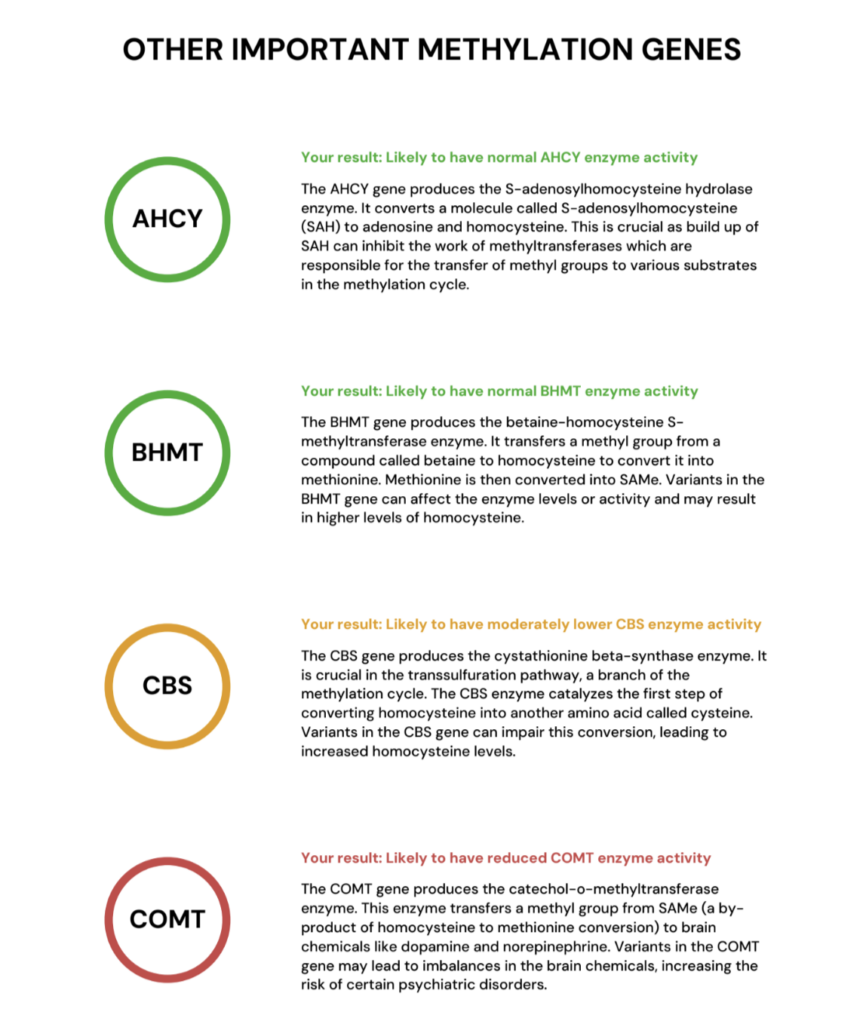
Improving methylation, a crucial biological process, can significantly impact overall health. Here are five natural ways to enhance methylation:
Bonus Tips
Additional strategies include increasing the intake of coenzyme Q10, phosphatidylcholine, folic or l-methylfolate, and vitamins B6 and B12, which are integral to the methylation process.
Maintaining gut health, improving stomach acid, and supplementing with antioxidants, magnesium, and zinc can also support proper homocysteine metabolism.
Remember, while these natural approaches can improve methylation, it's crucial to consult with a healthcare provider for personalized advice, especially regarding supplementation and diet modifications.
Methylation is a vital biochemical process in our bodies, influenced significantly by the MTHFR gene and its two important variants, C677T and A1298C.
These common genetic mutations, found in a significant portion of the population, can lead to elevated homocysteine levels and associated health risks.
The Xcode Life Methylation Genetic Test offers an in-depth analysis of these variants using data from popular ancestry testing services. It provides a comprehensive MTHFR report, helping individuals understand their genetic predisposition to methylation-related issues.
To support optimal methylation, adopting a nutrient-dense diet, supplementing appropriately, regular exercise, adequate sleep, limiting exposure to harmful substances, and reducing toxin exposure are key strategies.
Additionally, incorporating specific nutrients and supplements like coenzyme Q10, phosphatidylcholine, folinic acid, and vitamins B6 and B12 can further enhance methylation processes.
It's important to consult with healthcare professionals for personalized guidance and to ensure these natural methods align with your individual health needs.
https://www.nature.com/articles/npp2012112
https://www.medicalnewstoday.com/articles/326181
https://www.cdc.gov/ncbddd/folicacid/mthfr-gene-and-folic-acid.html
A vegan diet may have several benefits, such as reducing the risk of diabetes and heart and kidney disease and helping people lose weight. However, an unplanned vegan diet can result in nutritional deficiencies. In fact, some nutrients essential for the body are only found in animal products. In this article, we discuss whether vegans can be low on vitamin E and other nutrients and how to counter it.
Vitamin E falls under the group of fat-soluble vitamins.
This group also has vitamins A, D, and K besides vitamin E.
These vitamins play an important role in bodily functions and are best absorbed when taken with dietary fats.
Vitamin E, in particular, is an antioxidant.
This means it prevents free radical damage in your body and protects your cells.
Free radical damage can cause deadly diseases like cancer.
Vitamin E also supports metabolic functions, the immune system, gene expression, and cell signaling.
Daily dietary requirements of vitamin E can vary.
According to Australia's Nutrient Reference Value, these are the daily dietary dosages of vitamin E required in different groups of the population:
| Age Group | Vitamin E Requirement |
| Infants: less than 12 months old | 4-5 mg/day |
| Children: 1-10 years old | 5-8 mg/day |
| Adolescents: 14-18 years old | 8-10 mg/day |
| Adults: Above 19 years | 7-10 mg/day |
| Those who are pregnant and breastfeeding | 8-11 mg/day |
Vegans are usually not at a greater risk of being low on vitamin E.
Vitamin E is a fat-soluble vitamin that is stored in the body.
This means your body has a reserve of vitamin E that can be used when you run low on this nutrient.
Many foods included in a vegan diet, such as vegetable oil, nuts, seeds, and whole grains, are good sources of vitamin E.
Vitamin E deficiency can occur if you have a genetic condition or a chronic disease that makes uptake of vitamin E difficult or if you eat a diet that is extremely low in fats.
Liver diseases, gallbladder diseases, and pancreatitis are some diseases that cause malabsorption of fats.
This can lead to vitamin E deficiency in the body.
You might notice these symptoms if you have a deficiency of vitamin E:
Vitamin E supplements are generally not recommended for vegans and non-vegetarians.
For those who don't have any absorption issues, vitamin E requirements can easily be met through a balanced diet that includes healthy fats.
A diet that includes unsaturated fats and oils can help vegans meet their daily vitamin E requirements.
Vitamin E supplements can result in toxicity since this is a fat-soluble vitamin stored in the body.
Vitamin E has a blood thinning effect.
This means that supplements might be dangerous for people who are on blood-thinning medications like Warfarin.
Too much vitamin E can reduce blood clotting time and result in excess bleeding.
If you want to start taking vitamin E supplements, it is best to consult your doctor first.
Did You Know? Even if you are on a healthy diet, you might be at risk for nutritional deficiencies due to hidden genetic variants that impact nutrient metabolism. This is why many people feel tired and are on low energy most of the time.
Vitamin E is found in several plant products, fruits, and vegetables.
| Food Item | Serving Size: Vitamin E Content |
| Sunflower seeds (dry roasted) | 1 ounce: 7.4 mg |
| Hazelnuts (dry roasted) | 1 ounce: 4.3 mg |
| Wheatgerm oil | 1 tablespoon (20 mg) |
| Avocado | Half a fruit: 2.1 mg |
| Broccoli (boiled) | ½ cup: 1.1 mg |
| Mango | ½ cup sliced: 0.7 |
Apart from vitamin E, here are a few more nutrients that are hard to get on a vegan diet:
Vegans are usually deficient in the following:
Some vegan-friendly foods that are rich in vitamin E are:
Vitamin E deficiency can cause infertility in both males and females.
This nutrient protects cell membranes.
In men, vitamin E deficiency can lead to low sperm count, poor sperm motility, and poor semen quality.
In females, vitamin E deficiency can cause eclampsia, premature delivery, and miscarriage.
Vitamin E deficiency can show certain symptoms, which can help you understand that you might be deficient in this nutrient.
If you experience muscle weakness, fatigue, mental confusion, and depression, you might be deficient in vitamin E.
However, having these symptoms can also indicate the presence of other disorders.
That's why it is best to consult your healthcare provider to determine whether you are suffering from low vitamin E levels.
Vitamin E is a fat-soluble vitamin that plays a vital role in the body's normal functioning.
Most people are not deficient in this nutrient since it is widely found in various food items, and the excess is stored in the body as a reserve.
Vegans are not at an increased risk of deficiency since vitamin E is found in many plant-based foods such as nuts, seeds, oils, and whole grains.
Those who suffer from a vitamin deficiency have an underlying condition or disease.
However, vegans can be deficient in other nutrients such as vitamin B12 and vitamin D.
Taking supplements can help counter this.
However, it is always recommended that you consult a doctor before starting any supplements.
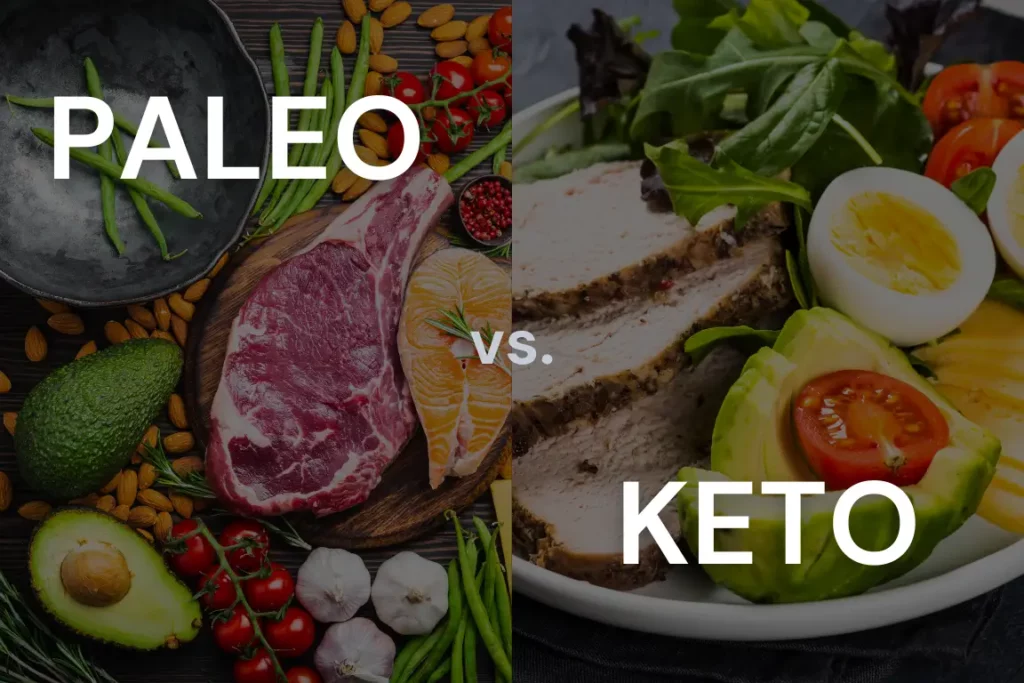
Paleo vs. Keto Diet: Which Is Better For Weight Loss?
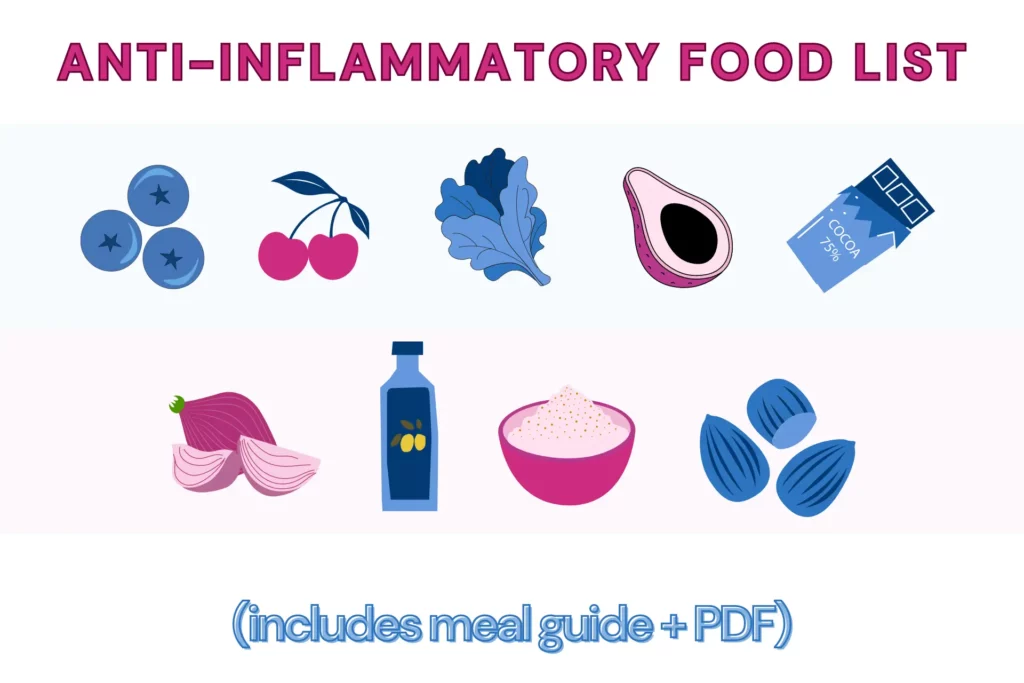
The Ultimate Guide To Anti-inflammatory Diet + Food List PDF
https://www.sciencedirect.com/science/article/pii/S0261561420306567
https://journals.eco-vector.com/1560-9596/article/view/112972
https://pubmed.ncbi.nlm.nih.gov/21947532
Searching for a sugar substitute that won't compromise your health? The market is filled with options, but it can be overwhelming to choose the right one. Today, we're shedding light on the debate - Truvia vs stevia, two natural sweeteners that have gained popularity. Join us as we uncover the truth about these alternatives and discover which might be the healthier choice for your sugar cravings.
Many people today prefer a low-sugar, no-sugar, or no-carb diet due to the adverse effects of sugar consumption.
Sugar is a type of carbohydrate, just like fiber and starch. There are different types of natural sugars.
For example, sucrose is a natural sugar found in fruits, vegetables, grains, and even dairy products.
Other natural sugars include:
Sugars, in moderate quantities, are essential for the body.
While natural sugars are healthy for you, consuming foods with added sugars can cause high blood sugar, insulin resistance, obesity, heart issues, and dental cavities.
Finding a sugar alternative today is relatively easy; however, it is important to understand why we need them.
Sugar substitutes are synthetically prepared or plant-based substances used to sweeten food or enhance the flavor of food and beverages.
Sugar substitutes can be of 3 types:
Artificial sweeteners: Zero-calorie sugar substitutes that do not contain sugar or any beneficial nutrients, are usually produced in laboratories, and are regulated by the FDA.
Examples: Neotame, aspartame, saccharin, sucralose, acesulfame potassium (Ace-K), advantage
The World Health Organization’s cancer research arm has labeled aspartame a “possible carcinogen.” A committee of 25 international experts has determined that aspartame may "possibly" cause cancer in people. There are several views about the safety of artificial sweeteners. Some experts believe these sweeteners pose health hazards. Studies are ongoing to determine the health risks of artificial sweeteners on humans.
Sugar alcohols: Synthetic compounds similar to artificial sweeteners but are not as sweet. They are added to foods for enhanced texture and taste but may cause gastrointestinal irritation, bloating, gas, and diarrhea.
Examples: Maltitol, sorbitol, xylitol, isomalt, lactitol
Novel sweeteners: Sugar substitutes derived from natural sources that are calorie-free, thus not leading to weight gain or spikes in blood sugar levels.
Examples: Stevia, allulose, monk fruit
A Harvard study identified three sugar substitutes to be associated with health risks:
Stevia and monk fruit are “generally regarded as safe,” which means they are safe to consume.
Stevia is an all-natural, calorie-free sweetener derived from Stevia rebaudiana (a herb).
The herb contains rebaudioside A, the sweetest compound in the stevia leaf.
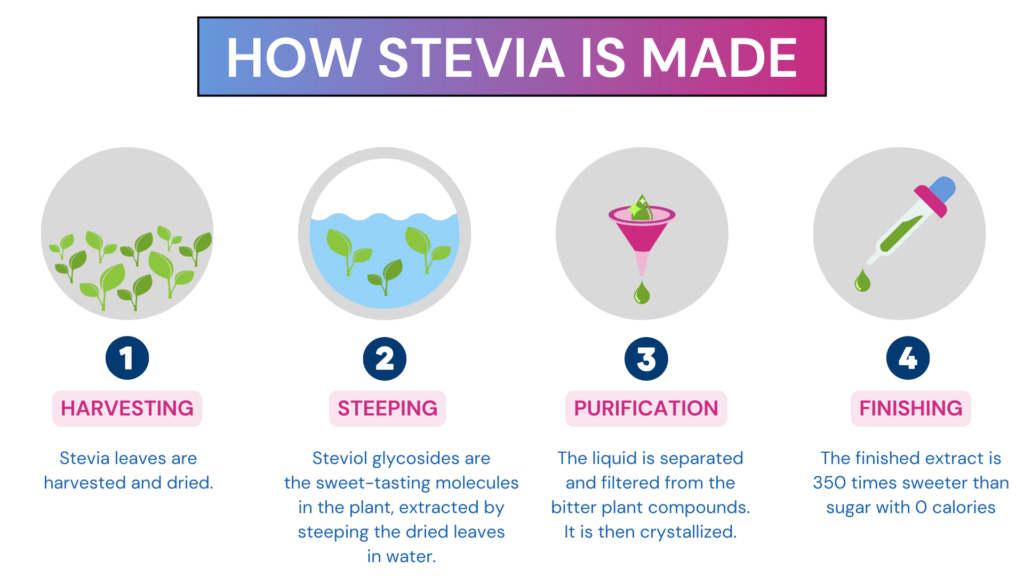
The FDA has labeled rebaudioside A as ‘generally recognized as safe (GRAS).’
Stevia is a versatile sweetener that can be used as a sugar substitute in cooking, baking, and preparation of beverages.
Compared to regular table sugar, stevia is way sweeter, and some people complain of a slightly bitter aftertaste.
Here are a few pros and cons of stevia:
| Pros | Cons |
| Vegan and vegetarian-friendly | Costlier than regular sugar |
| Provides sweetness with zero calories | Not all products contain pure stevia |
| Gluten-free, non-GMO | Difficult to bake with |
| Better for the environment |
Truvia is the brand name for a sugar alternative launched by the Cargill company in 2018.
It combines stevia leaf extract with erythritol (sugar alcohol) and added flavors.
The 3 g of carbohydrate in Truvia comes from erythritol.
But, since the body does not absorb this alcohol, Truvia is said to be zero calories.
| Pros | Cons |
| Gluten-free Organic and non-GMO | Costlier than sugar |
| Provides sweetness without calories | Known to cause gastrointestinal issues |
| Taste and texture similar to sugar | Some people complain of an unpleasant aftertaste |
A few health benefits of Truvia include:
May have anti-diabetic and anti-hyperglycemic effects
Erythritol is believed to have anti-diabetic and anti-hyperglycemic effects.
Since this sugar alcohol does not cause a rise in insulin levels or blood glucose levels, it may be a good sugar substitute for people with diabetes and prediabetes.
May improve dental health
Since Truvia does not contain sugar, it may reduce the incidence of tooth decay and cavities.
Research states that erythritol prevents the growth of Streptococcus mutans, a bacterium known to cause dental decay.
Some studies state that erythritol may have antioxidant properties.
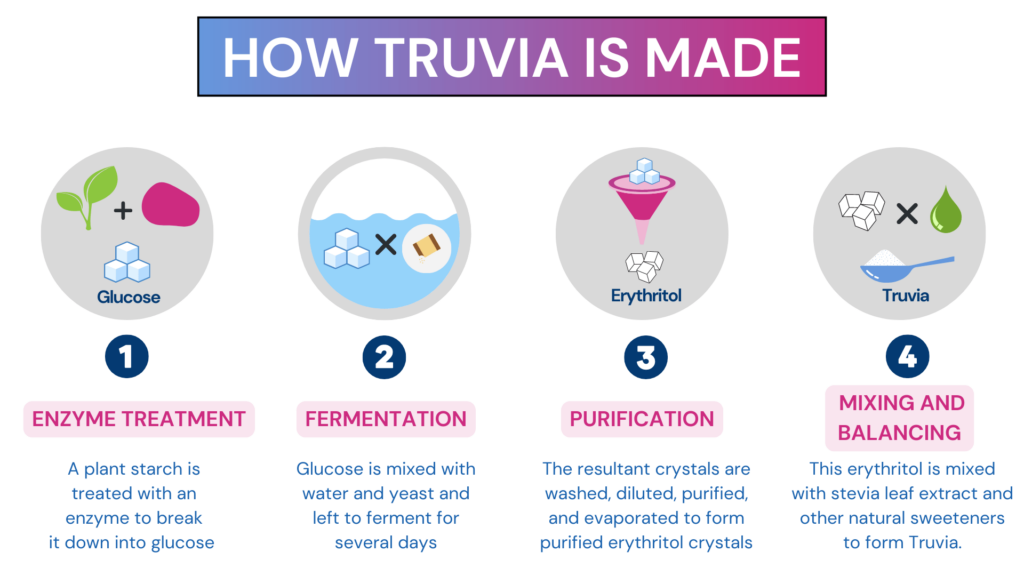
| Stevia | Truvia | |
| Calories | 0 | 0 |
| Carbs | 1 g | 3 g |
| Fat | 0 g | 0 g |
| Protein | 0 g | 0 g |
| Fiber | 0 g | 0 g |
| Sodium | 0 mg | 0 mg |
| Vitamins and Minerals | 0 mg | 0 mg |
| Added sugar | nil | Erythritol (sugar alcohol) is added to stevia to make Truvia |
| Glycemic Index | 0 | 0 |
| Taste | Stevia liquid extract is considered to be 15 to 30 times sweeter than table sugar. Stevia powder is 200 to 300 times sweeter than sugar. | Sweeter than stevia. |
| Benefits | May be beneficial for glucose and insulin response May prevent dental caries May have a blood pressure-lowering effect | May have anti-diabetic and anti-hyperglycemic effects May improve dental health May have antioxidant properties |
| Side Effects | Some people may develop an allergy to stevia. | May impact gut health in some individuals May cause laxative effects May cause bloating, stomach pain, and gas, especially in people with irritable bowel syndrome (IBS) |
A joint statement by the American Heart Association and American Diabetes Association said that stevia and a few other sugar substitutes may benefit people with diabetes.
However, they must be used in recommended amounts.
A few health benefits of stevia for people with diabetes include:
A 2016 study found that stevia leaf powder significantly lowered blood sugar levels in people with diabetes (fasting and post-prandial levels).
Like stevia, Truvia does not cause a rise in blood sugar levels, making it a safe sugar substitute for people with diabetes.
If you have diabetes or prediabetes or wish to manage your blood sugar levels, ask your doctor for the best possible sugar substitute.
Even though Truvia contains stevia, many nutritionists pick stevia as the better and safer option for consumption.
This is because stevia is less processed than Truvia and does not contain sugar alcohol like erythritol, which may cause gastrointestinal side effects.
Truvia’s erythritol content (a sugar alcohol) can cause digestive issues like bloating or diarrhea in some people, especially if consumed in large amounts. Additionally, Truvia is a processed product combining stevia extract with other ingredients, which may not appeal to those seeking a less refined sweetener.
There’s no one-size-fits-all “healthiest” sweetener. Plant-based options like stevia and monk fruit are generally recognized as safe and contain few or no calories. However, experts often emphasize using any sweetener in moderation and focusing on an overall balanced diet.
Highly purified stevia extracts are considered safe by the FDA, but whole-leaf or crude stevia is not approved for widespread use due to concerns about its possible effects on blood sugar, reproductive systems, and more. Some people also report a bitter or metallic aftertaste.
Is monk fruit better than stevia?
Both monk fruit and stevia are zero- or low-calorie sweeteners derived from plants. Evidence suggests neither is universally “better” than the other; it often comes down to personal taste, tolerance, and how each sweetener fits into an individual’s overall diet.
Stevia, monk fruit, and erythritol-based blends can all reduce added sugar in coffee. However, many health experts recommend gradually scaling back any sweetener to help reset taste preferences and encourage a more balanced diet overall.

Erythritol vs. Xylitol: Which Is The Healthier Sugar-Free Option?
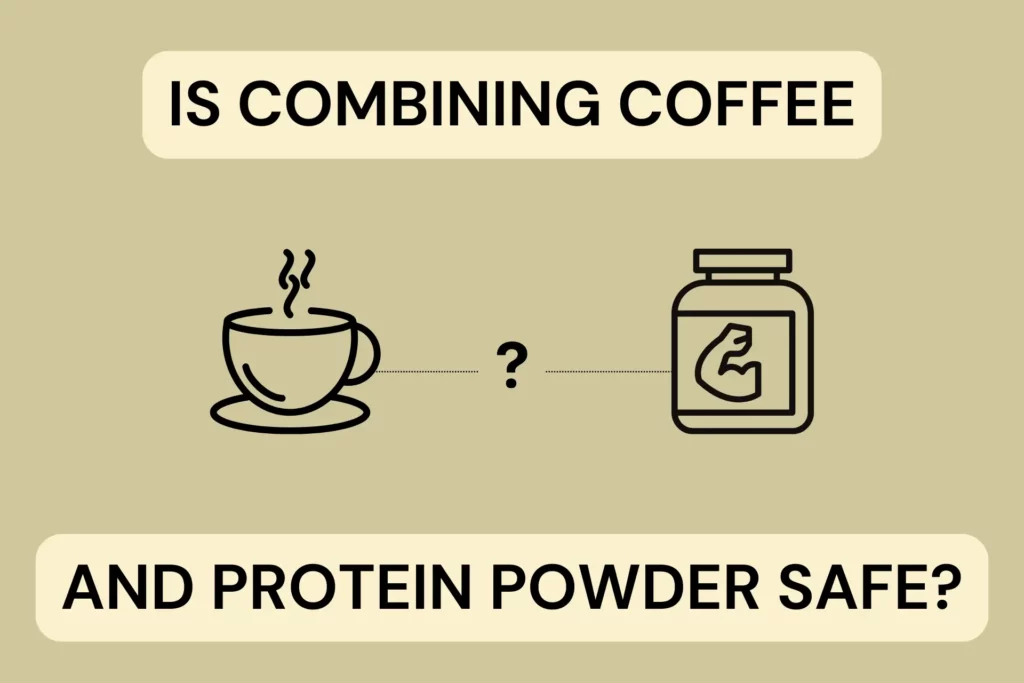
Is Coffee And Protein Powder Combination Safe? Experts Weigh In